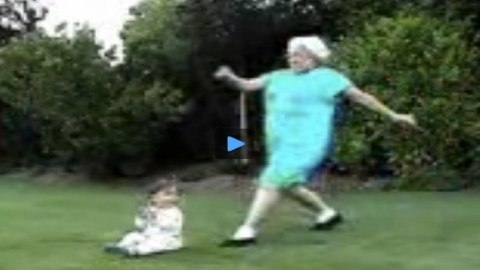What Videos of Babies Getting Clobbered Say About the Internet

Google the words ‘baby’ and “owned” in the Videos tab, and you’ll find a curious phenomenon: A fair number of people have put up vids of infants and toddlers getting conked, clobbered, whacked and tripped—like this. Some are clearly film tricks, like this weird Spanish series, which had several episodes, and which is quite funny only because it’s obvious no one was hurt. But a lot depict genuine thumps, and some offer slow-mo replays like this guy’s, so you won’t miss any detail of the moment of impact. I found myself wondering what that says about the Net, and its effect on people.
I began with the assumption that it’s not about actual babies. Spend time around an actual infant, and you soon see that their existence is filled with hard work, so rich in bafflement and frustration and a ceaseless effort to understand. Who’d want to make their days even harder? Answer (I’m pretty sure): Very, very few of us.
However, a YouTube video of a kid you don’t know isn’t really about that kid. Your digital engagement—as you trim it, slow it down, speed it up, set to music and mash it up with other vids—transforms it into a video about you. The real child, somewhere back in 2003, somewhere in Whereverplace, is just the origin point for the material that you use to make your statement. And your statement is, basically, Nelson’s hah-hah (lookit that little kid getting smacked!)—the video cousin of that baby-shaker app that appeared and then quickly vanished from the iPhone app store in 2009. What prompts people to make this particular statement?
My hunch: The trigger is America’s obnoxious baby-advice industry—the people who borrow real infants’ importance and fragility to lend authority to their bossiness. Penelope Leach’s book, for instance, includes sections called “Parents Have Their Say” in which the “say” is something normal and human (like Why does everyone try to make me feel guilty?) and the reply puts the parent firmly in her place: “that’s the tit-for-tat thinking of a child being bullied by another child, and the simple answer, of course, is that you aren’t a child.” Of course! Penelope Leach isn’t bullying you, my dear—she’s your teacher! From a different book, here’s another example of that advice-book tone, at once condescending and Captain Queegish: “The colors of the bed sheet must be soft and soulful. Too much contrast and bright colors might keep the baby awake. The crib and the room in which the baby is kept must be really inviting and clean. The kid must feel absolute peace and cool and restful nature in the room where she is kept.”
Inviting and clean? Puh-lease. Babies happily eat dust balls, dead flies and their own poop until parents learn to duct-tape their diapers. “Inviting” to a baby is a pot of boiling water with a clown’s head in it—so warm! so many colors! so much motion! All this precious advice isn’t for the benefit of babies; it’s about the absolute necessity, the biological need, because our children are the future, to obey the personal preferences of the author. People subjected to that naturally develop a certain resentment. If you’re a 14 year old boy, you feel a Darwinian sense of threat when you contemplate all those precious parental resources being lavished on an infant, and not you. If you’re a 22-year-old male slacker, Penelope Leach and her ilk will remind you that you’re scared witless of parenthood. And if you’re a parent, you just want to tell this industry of self-appointed meddlers to get out of your face. And those three demographics, according to my extremely unscientific survey, are the ones posting the clobbered-baby videos.
All of which I think illustrates Adam Gopnik’s point, made last month in a review of attitudes toward the digital age, that digital media don’t really bring the social world into our heads. Rather, our tools bring what’s in our heads out to the social world. Gopnik’s term for this, “the inverted self,” is a cousin to Tom de Zengotita’s “flattered self”: What both writers have noticed is that always-on media makes all experience an experience about the viewer. So our tools, which seem to invite a more public life, actually make that public life recede into the background. They throw us back into our private selves, by bringing our secrets out into public space, as Gopnik nicely explains: “what we […] have always in the past socially restrained if only thanks to the look on the listener’s face—the monstrous music that runs through our minds is now played out loud.”





